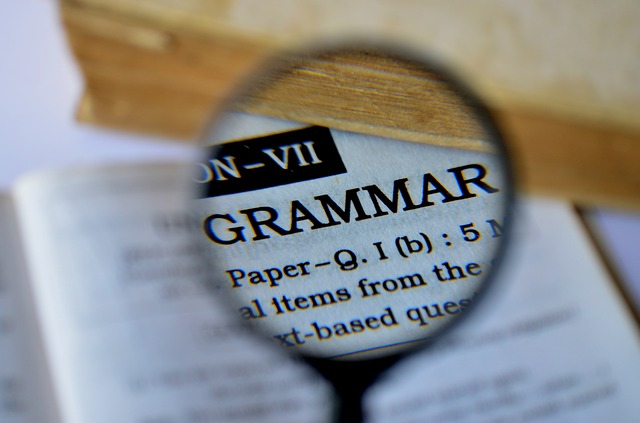Grammar Spotlight
 The English Grammar Profile (EGP) is a sister resource to the English Vocabulary Profile, and has been put together by Anne O'Keeffe (Limerick University) and Geraldine Mark, the co-authors, along with Ron Carter and Mike McCarthy, of English Grammar Today (Cambridge University Press). Mark and O'Keeffe investigated the extensive data in the Cambridge Learner Corpus to establish when learners begin to get to grips with different linguistic structures.
The English Grammar Profile (EGP) is a sister resource to the English Vocabulary Profile, and has been put together by Anne O'Keeffe (Limerick University) and Geraldine Mark, the co-authors, along with Ron Carter and Mike McCarthy, of English Grammar Today (Cambridge University Press). Mark and O'Keeffe investigated the extensive data in the Cambridge Learner Corpus to establish when learners begin to get to grips with different linguistic structures.
A series of insights from their research will be posted on this page, each one putting the spotlight on an interesting aspect of learner grammar development. Please note that all of the learner examples come from the Cambridge Learner Corpus, a 55-million word electronic collection of written learner data. The examination and the candidate’s first language are given in brackets after each learner example.
See the latest Grammar Spotlight entry below. Scroll right down to the bottom of this page to browse through previous entries.
C1 level learners can use a variety of fixed expressions (many of which are prepositional phrases) in the front position for focus. At this level many fixed expressions are used by learners non-literally for focus.
 At the end of the day, everything is up to you! (Cambridge English: Advanced; Greek)
At the end of the day, everything is up to you! (Cambridge English: Advanced; Greek)
 All in all, the activity week was a nice experience for both students and teachers. (Cambridge English: Advanced; Greek)
All in all, the activity week was a nice experience for both students and teachers. (Cambridge English: Advanced; Greek)
 All things considered, I would recommend the third proposal as it seems to me that it covers most of the points the students have been complaining about. (Cambridge English: Advanced; Italian)
All things considered, I would recommend the third proposal as it seems to me that it covers most of the points the students have been complaining about. (Cambridge English: Advanced; Italian)
 When it comes down to it, who does not like such a surprise? (Cambridge English: Advanced; Portuguese)
When it comes down to it, who does not like such a surprise? (Cambridge English: Advanced; Portuguese)
Learners at this level can also use imperatives as pointing devices within texts for focus.
 Note the disadvantages of this transfer. (Cambridge English: Advanced; Greek)
Note the disadvantages of this transfer. (Cambridge English: Advanced; Greek)
 Notice the difference in the salary. (Cambridge English: Advanced; Spanish - Latin American)
Notice the difference in the salary. (Cambridge English: Advanced; Spanish - Latin American)
 See the written instructions on the phone for complete instruction. (Cambridge English: Advanced; Swedish)
See the written instructions on the phone for complete instruction. (Cambridge English: Advanced; Swedish)
Learners are also able to use the cleft clause What + noun or pronoun + verb phrase as subject + be for focus.
 What I found particularly fascinating about this story is that it is still exciting and thrilling, despite the plot being rather easy to follow. (Cambridge English: Advanced; Greek)
What I found particularly fascinating about this story is that it is still exciting and thrilling, despite the plot being rather easy to follow. (Cambridge English: Advanced; Greek)
 What companies care about is money and football players help them to earn it. (Cambridge English: Advanced; Catalan)
What companies care about is money and football players help them to earn it. (Cambridge English: Advanced; Catalan)
 What students learn are mostly facts and theories. (Cambridge English: Advanced; Korean)
What students learn are mostly facts and theories. (Cambridge English: Advanced; Korean)
Learners also use Wh-cleft clauses as titles or subtitles to point to something that follows.
 Why I think this is a good idea
Why I think this is a good idea
People are sensitive, and when they hear about charities, they always want to help. (Cambridge English: Advanced; Greek)
 How I investigated
How I investigated
First I started looking on the internet in general. (Cambridge English: Business Higher; German)
Finally, learners are able to use a non-finite subordinate clause with an -ed form before a main clause for focus, often in formal, academic or business contexts.
 Compared to other European capitals, there has been a lot done to make riding a bike less dangerous and more comfortable in Berlin. (Cambridge English: Advanced; German)
Compared to other European capitals, there has been a lot done to make riding a bike less dangerous and more comfortable in Berlin. (Cambridge English: Advanced; German)
 Outlined below are some essential reasons which justify my choice and should be seriously considered. (Cambridge English: Advanced; Greek)
Outlined below are some essential reasons which justify my choice and should be seriously considered. (Cambridge English: Advanced; Greek)
So, learners at the C1 level use fixed expressions, imperatives, cleft clauses and non-finite subordinate clauses for focus in their writing. Although this level of skill is impressive, more progress is to be made at the C2 level.






